Category Archives for Aviation
Chris Palmer (aka Angle of Attack) Dubs Garmin GI 275 EIS a Must for Older Planes
The flight instructor and aviation YouTuber says the peace of mind provided by his GI 275 is irreplaceable when working in the wilds of Alaska.
Chris Palmer is a career certified flight instructor and the founder of an Alaska-based flight school, Angle of Attack. So when considering instruments for the panel in his Cessna 172, he prioritized efficiency and ease-of-use — and the Garmin GI 275 Engine Indication System (EIS) was a no-brainer.
“It really cleaned up my panel,” Palmer says. “I had those old mechanical instruments that were unreliable and inaccurate, and now I have by-the-number accuracy on the 275. It also gives you at-a-glance information, so instead of looking at the number directly, you may just look at it being in the green or red or yellow. And of course, the user interface for those instruments is so good that if anything is wrong, you’ll see a notification right away, so that’s really nice as well.”
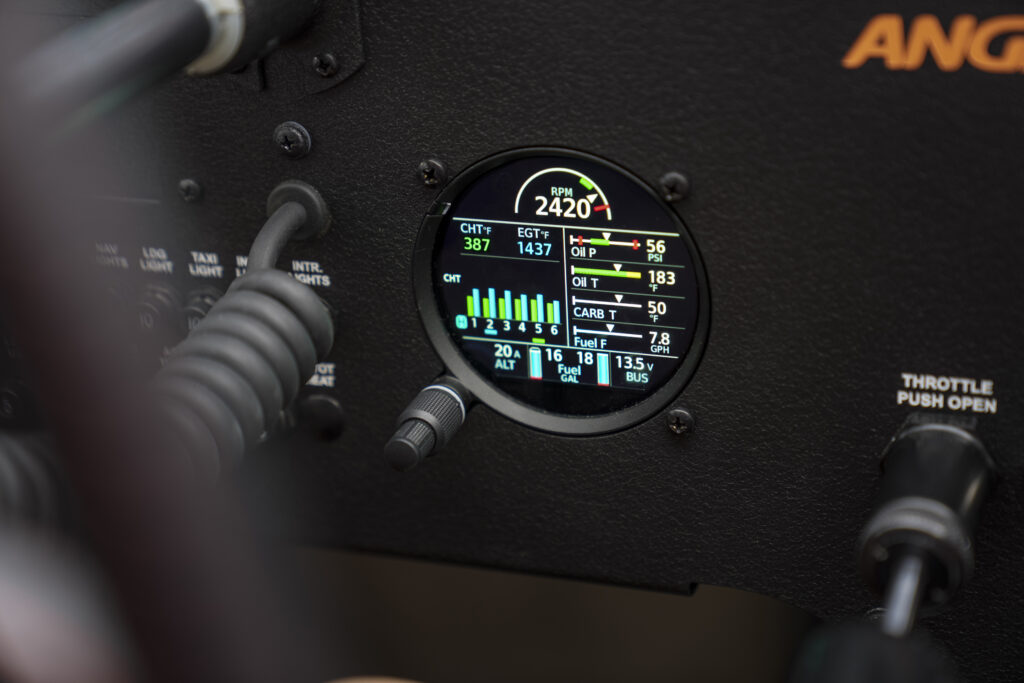
But the biggest advantage of the GI 275, he says, is that the primary engine monitoring solution replaces all analog engine gauges. In one display, you can easily ascertain engine, fuel and electrical information, allowing you to fully manage engine operation with all the readouts you need in convenient location — with multiple pages for easy access.
“It replaced every instrument on the righthand side of my panel. It’s now all down to one round dial instrument, which leaves room for other activities.”
For Palmer, who flies predominately in what he dubs the inhospitable terrain of the Alaskan bush, his favorite component of the EIS is less a specific feature and more a feeling it inspires.
“It’s about the peace of mind,” he says. “I came from very primitive engine information to where now I have everything I could ever want. You do not want engine problems out here. So having that insight into my engine at all times has been extremely comforting — I didn’t realize how much anxiety it was causing me to not have all that information.” Now he can monitor every cylinder. “It just gives me comfort knowing that if I see trends or see something wrong, I can be ahead of it and potentially land somewhere if there’s an issue.”
Another bonus to choosing Garmin to manage your engine operation? “I really like that it’s not a set-in-stone piece of hardware — in other words, Garmin updates over time. They’ve already updated the user interface, and I like that about it because you get new and improved information and layout.”
In his work with his flight school, Palmer encourages pilots (and aspiring pilots) to take the plunge and install a GI 275 EIS.
“There is so much going on in your engine that you don’t realize, and you’re kind of just at the mercy of your mechanic and the maintenance process and whoever is maintaining your airplane, without having the information at your fingertips all the time. And again, going back to it, just the sense of comfort —your engine is the most important thing on the airplane other than the wings. All the time that it’s running well and you’re not having issues, it’s blissful ignorance without an instrument like that. I don’t like blissful ignorance anymore — I’d rather have my information, and if it’s not good news, then I’ll get on the ground, and I’ll be safe. Out of all the instrumentation I upgraded with the airplane, my engine monitor, the GI 275, is my favorite, and it’s the one I appreciate the most.”
To learn more about the GI 275 EIS, click here. Visit Palmer’s YouTube channel, Angle of Attack, for aviation education and entertainment, or angleofattack.com to learn more about online ground school.
The post Chris Palmer (aka Angle of Attack) Dubs Garmin GI 275 EIS a Must for Older Planes appeared first on Garmin Blog.
https://www.garmin.com/en-US/blog/aviation/chris-palmer-aka-angle-of-attack-dubs-garmin-gi-275-eis-a-must-for-older-planes/
Six Lessons Learned from a Garmin Panel Makeover
Josh Flowers and his father bought N80991, a 1976 Cessna 172 Skyhawk, more than 9 years ago. Since then, that aircraft has become the centerpiece for the online aviation videos he posts as @Aviation101Films that share the passion and craft of flight. When it came time to redo the interior — creating his “better than brand-new 172” — it made sense that the Garmin ambassador would give the airplane a full Garmin panel.
But adding the new avionics — including dual G3X Touch flight displays, a GTN
flight displays, a GTN 750Xi navigator, a backup G5 display, a remote Garmin audio panel, GNC® 255 radio, GTX
750Xi navigator, a backup G5 display, a remote Garmin audio panel, GNC® 255 radio, GTX 345 transponder, GFC
345 transponder, GFC 500 two-axis autopilot with auto trim and more — required a full redo of the panel. It was an exhaustive process. It’s no wonder, then, that he has some valuable lessons to share that can help you navigate a panel upgrade of your own.
500 two-axis autopilot with auto trim and more — required a full redo of the panel. It was an exhaustive process. It’s no wonder, then, that he has some valuable lessons to share that can help you navigate a panel upgrade of your own.
1. Pick a shop you trust.
You’ll spend a lot of quality time with them, and they’ll spend many man-hours inside your airplane. Plus, you’ll be flying behind their work, sometimes in IMC conditions. Professionalism, attention to detail and meticulous work are key.
“Seeing an airplane that you’re so familiar with be gutted down to the aft side of the firewall gave me an overwhelming feeling of ‘what have we done?’” Josh says. “I knew good and well the experts at Daytona Aircraft Services were going to take their time to do this project right, and this airplane was going to be far better and safer than it was on the trip out there.”
2. Gut it if you can.
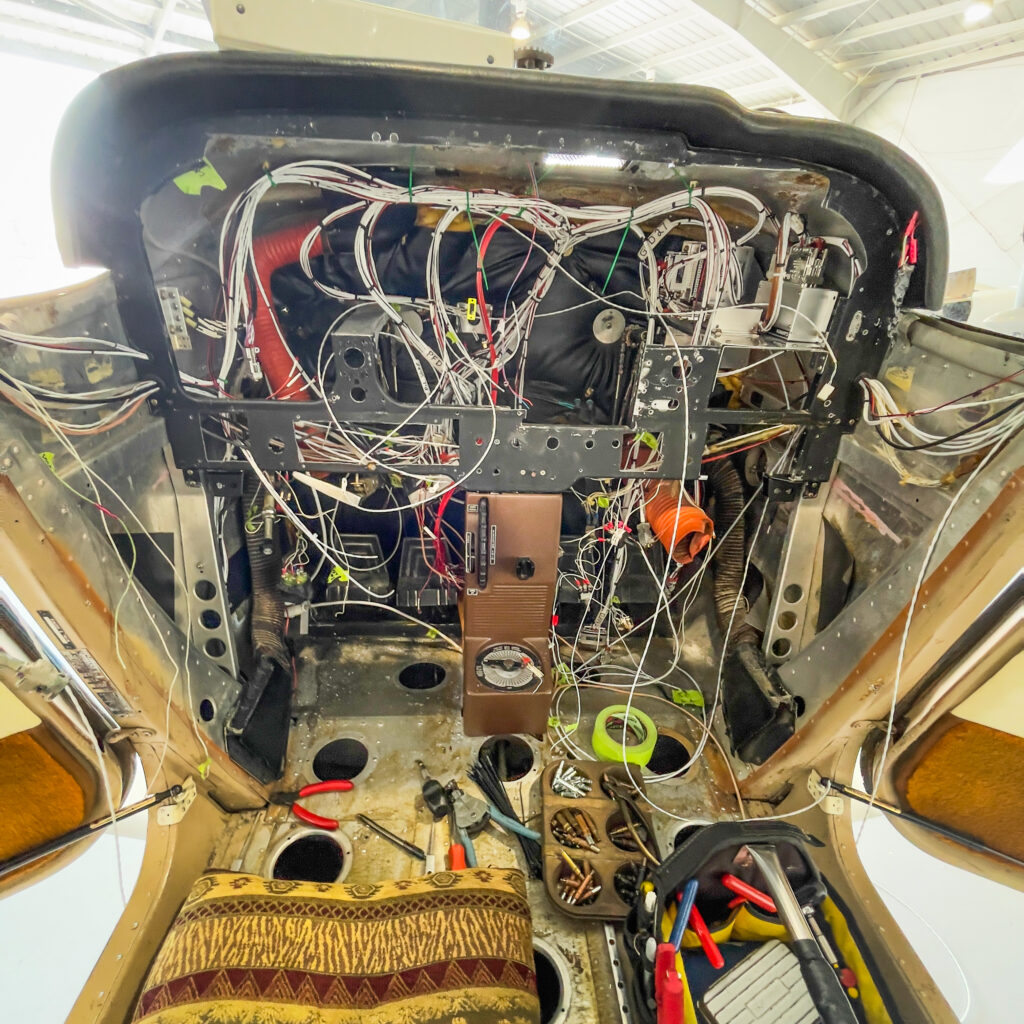
The shop crew started disassembly by tracing every wire — what it’s from and where it goes. They removed wiring from previous upgrades that didn’t need to be there anymore, then freshly rewired the whole airplane. That was a mind-blowing experience, Josh says, seeing how much stuff can be wrong or unsafe in an airplane that pilots don’t even really know about — and don’t even notice. “I think that’s why it’s so important that, if you’re going to do a major retrofit like this, you’ve got to gut it,” Josh says. “You’ve got to pull everything out and just redo everything.”
3. Measure twice, cut once.
Creating a custom panel is part art, part technical skill, and the shop used a multistep process to get everything to fit properly. They started with a generic CAD drawing of the panel for his model Skyhawk, cut a panel out of clear plastic on a CNC router for a trial fit, tweaked the drawing where changes were needed and made new versions.
“They basically keep cutting new plastic pieces as many times as they need until the design is laid out and fits everything in the airplane perfectly,” Josh says. “Then they’ll cut their final panel out of 0.090 aluminum using that final CAD design.”
Ultimately, they moved switches to more logical places and added a Garmin GSB 15 USB port, Garmin Smart Glide
15 USB port, Garmin Smart Glide switch, a CO detector and 406 MHz ELT remote switch. They also refabricated mounting rails to position the G3X Touch displays over the yokes and center the avionics stack so they could install the new equipment securely. The goal wasn’t just to make the panel attractive, but also to make it strong and stout. “I am mind-blown by this shop’s attention to detail,” Josh says.
switch, a CO detector and 406 MHz ELT remote switch. They also refabricated mounting rails to position the G3X Touch displays over the yokes and center the avionics stack so they could install the new equipment securely. The goal wasn’t just to make the panel attractive, but also to make it strong and stout. “I am mind-blown by this shop’s attention to detail,” Josh says.
4. It takes time to test everything.
While the panel may look finished once everything is installed, there’s still a lot left to do. The shop went through every single setting and configured systems for the airplane as laid out by the Garmin Supplemental Type Certificate. That includes such minutia as autopilot servo torques and gains, checking CAN bus communication to ensure the networked avionics talk among each other and complete troubleshooting. “This takes a long, long time, and it’s very tedious,” Josh says.
At the end of the installation, a new weight-and-balance calculation indicated the aircraft gained 60 pounds over its logbook weight. Josh attributes that to imprecise record-keeping over the life of the airplane. That could have serious implications when it’s flown near gross weight, so it’s critical insight as he flies the aircraft into its second life.
5. Learn the new equipment.
The airplane had dual G5 flight instruments, so Josh was familiar with flying behind an EFIS. But while the full panel added awesome new cross-country capabilities, it also injected new levels of integration and greater complexity into Josh’s flying. Before he ever flew his upgraded airplane, he smoothed the avionics learning curve by training in Daytona Aircraft Services’ RV-7, which has an almost identical panel.
“I’m finding that letting the autopilot completely do the approach for you, it’s like another skill set to maintain situational awareness when you’re not the one actively flying the airplane,” Josh says. “I’ve been familiarized with all these avionics. But I have some proficiency to catch up on with this entirely new panel.”
6. Make sure everything works before you depart.
Once the retrofit was complete and he was up to speed, he flew several flight-test missions with shop pilots to ensure everything worked properly. That attention to detail is an important final step. “They want to get things right the first time instead of rushing through it, and the customer having to bring the airplane back to them with an electrical or mechanical issue,” Josh says.
Now that he has the airplane back, he’s excited by how gorgeous — and now how safe — his airplane has been put together. It’s practically a different airplane, and he’s ready for the aviation adventures it’ll make possible.
“This autopilot, the dual G3X Touch, the GTN 750Xi, I think all of this is going to be a game-changer for me — it’s going to make me enjoy cross countries more,” Josh says. “I’m super excited about all of this.”
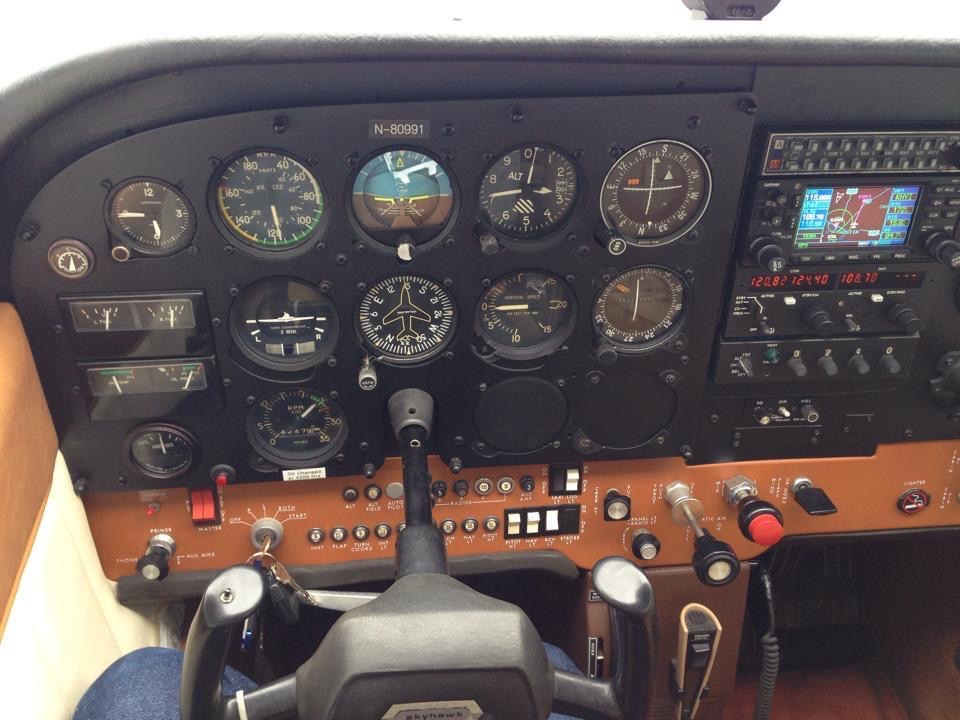
The post Six Lessons Learned from a Garmin Panel Makeover appeared first on Garmin Blog.
https://www.garmin.com/en-US/blog/aviation/six-lessons-learned-from-a-garmin-panel-makeover/
Stevie Triesenberg, aka Bayflight, on Being a Female Pilot and Her Introduction to Aviation
An aviation influencer in her own right, Triesenberg has Instagram to thank for her transition from a young girl who wouldn’t even board a plane to a woman who is now encouraging others to pursue a pilot’s license.
Stevie Triesenberg didn’t grow up with much exposure to airplanes.
“I actually wouldn’t ride on commercial airliners through the majority of school, because I would get ear pain,” she says.
And yet you may now know her as Bayflight, thanks to her knack for social media where she chronicles her adventures in her 1952 C35 Bonanza — which is, of course, outfitted with Garmin avionics. So how does one go from a young girl who won’t even board a plane to a woman who is making a name for herself in an industry comprised predominantly of men? Pure chance.
“I was on Instagram one day and saw a photo of a friend of a friend of a friend on my explore page flying a Cirrus around Lake Michigan,” says Triesenberg. “I was like, ‘Wait a minute, that’s a small airplane.’ I didn’t know you could just fly for fun. I didn’t know you could just go get a recreational or private license — I didn’t know the terminology at the time. I didn’t know how pilots trained. I didn’t know anything. That photo threw me off. I thought that was really cool, and I’d love to do that just for fun.”
As is the case when most seeds are planted, the idea took some time to come to fruition. Triesenberg was already planning to head to engineering school in pursuit of a career as a software engineer, and she stayed the course. Every summer, though, she’d come back to the idea, browsing the internet for used small airplanes and dreaming of owning and flying one someday. The summer after her sophomore year of college, she had a computer science internship in Ann Arbor, Michigan, and decided it would be the perfect time to get her pilot’s license.
She picked the school with the best website and never looked back. “I completely fell in love with it,” she says. Five years after enrolling, she’s got more than 300,000 followers on her aviation Instagram account and is leading the charge for younger generations to enter the space.
“It was all just because of this Instagram post that I saw, and so it’s come full circle for me, being on social media and having all these young girls especially look up to me, because that’s what I was more than 5 years ago. I was that young girl who saw a picture of an airplane and thought that was cool.”
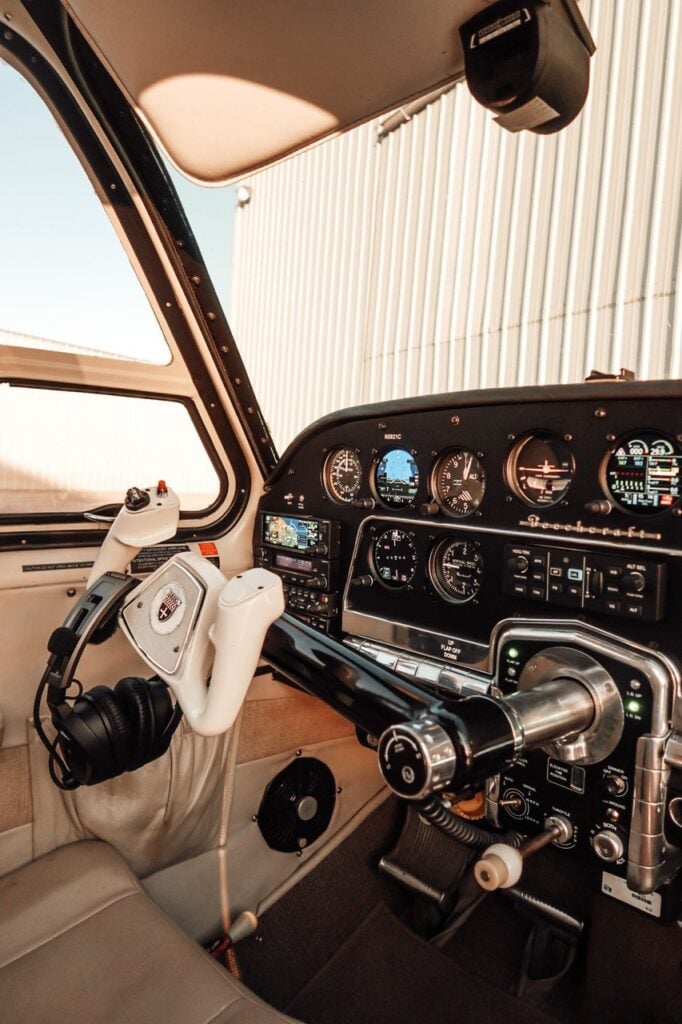
The social media component of her role in the aviation space is a creative outlet, says Triesenberg, noting that her daytime gig as a software engineer means she spends much of her life typing away code on a keyboard. As she got more interested in flying, she realized Instagram was also home to a huge aviation community.
“It’s almost like high school — everybody knows everybody in some way through aviation Instagram.” It’s also helped her to feel like she’s not the only woman in the room, despite the fact that varying studies still have the percentage of women pilots in the industry sitting somewhere in the neighborhood of 7 percent.
“I feel very fortunate that when I started flying, the assistant chief flying instructor at my club was one of the most accomplished female pilots I’ve met to date,” she says. “So right off the bat, I didn’t even know about the statistics of there being only 7 percent of women who had their pilot’s license in aviation.”
“I never felt like the only woman in the room,” she says, noting that she was also surrounded by many other female college students going through flight school at the same time. “I feel very lucky to be in that position, because I know that’s not a common experience.”
As her flight logs and Instagram followers have grown, so have Triesenberg’s connections in the aviation industry. It’s how she was introduced to the team at Garmin and how she learned exactly what she wanted in dreaming about a panel upgrade for her vintage Bonanza. She’s now fully outfitted with Garmin avionics, but she quotes two products in particular that she can’t live without.
“I love the GI 275 EIS system, because it gives me so much more information and confidence,” she says. “And the GFC 500 autopilot makes a world of difference on cross-country flights. I went to Oshkosh last year a week after I got the new panel, and it made flying so much easier. I flew from Michigan to California previously without an autopilot and didn’t know what I was missing out on, but now that I have it, I don’t know how I ever did that before.”
500 autopilot makes a world of difference on cross-country flights. I went to Oshkosh last year a week after I got the new panel, and it made flying so much easier. I flew from Michigan to California previously without an autopilot and didn’t know what I was missing out on, but now that I have it, I don’t know how I ever did that before.”
To follow along on Triesenberg’s adventures, view her Instagram @Bayflight or her YouTube account with the same handle.
The post Stevie Triesenberg, aka Bayflight, on Being a Female Pilot and Her Introduction to Aviation appeared first on Garmin Blog.
https://www.garmin.com/en-US/blog/aviation/stevie-triesenberg-aka-bayflight-on-being-a-female-pilot-and-her-introduction-to-aviation/
Recon SpraySense™ Receives AE50 Award from ASABE

We’re excited to announce that the Intelligent Ag™ solution, Recon SpraySense™ has received an AE50 award for 2023 from the American Society of Agriculture and Biological Engineers (ASABE). This recognition is awarded annually by a diverse panel of engineering experts from around the world.
We are thrilled that Intelligent Ag™ and Recon SpraySense™ were named among 50 of the best innovations in engineering and technology for agriculture, food, and biological systems in the country.
View the full list of award recipients here.
https://appareo.com/2023/01/11/spraysense-receives-ae50-award/
2022 Garmin Holiday Gift Guide
Make your list and check it twice with Garmin.
Looking for ideas for holiday gifts? Look no further — Garmin has the perfect gift for anyone’s list. Whether you’re shopping for the runner in your life or the pilot (or both), our wide selection of purpose-built products will help you find the present that’s just right for that special someone.
To support their running journey:
Forerunner 255® Series: GPS Running Smartwatches
You’re making strides. Now let’s take the next step. Get the training and recovery insights you’ll need to notch your best time yet.
Forerunner® 955 Solar: Advanced Solar Powered Running Smartwatch
Train your best, perform your best and outlast the pack with a Power Glass solar charging lens to extend battery life.
solar charging lens to extend battery life.
To help them never stop cycling:
Edge® 1040 Solar: Solar Powered Cycling Computer
Never stop cycling with the ultimate solar powered GPS bike computer you can depend on when you need it most.
Edge® Explore 2: GPS Cycling Computer
When you need a dependable, easy-to-use GPS cycling computer, this Edge helps you ride on and discover new trails.
To catch their every beat:
HRM-Pro Plus: Premium Heart Rate Monitor
Plus: Premium Heart Rate Monitor
Whether you’re training indoors or out, this heart rate strap provides the accurate data you need to push limits and reach goals.
To promote their healthy lifestyle:
vívofit® jr. 3 Series: Kids Fitness Trackers
It’s not just a fitness tracker for kids. It’s an interactive experience where your child’s activity unlocks exciting adventures.
Venu® Sq 2 Series: GPS Smartwatches
Discover new ways to move and get a 24/7 picture of your health — in one, sleek smartwatch.
Understand your body better and enjoy the convenience of making calls from your wrist when paired with your compatible smartphone.
vívomove® Sport: GPS Smartwatch
This hybrid smartwatch combines the traditional look of an analog watch with the essential smart features you need to keep up with your busy life.
To unleash their inner explorer:
fēnix® 7 Series: Multisport Smartwatches
These rugged multisport GPS watches blend cutting-edge design and performance with 7-day-a-week wearability.
epix (Gen 2): Premium Active Smartwatch
(Gen 2): Premium Active Smartwatch
Regardless of your fitness goals, this smartwatch has what you need to help you get there and be epic.
Descent G1 Series: Dive Computers
G1 Series: Dive Computers
Land or sea, this compact dive computer is built for both of your worlds — and with the solar version, you can even harness the power of the sun.
Instinct® 2 Solar Series: Solar Powered Multisport Smartwatches
These rugged, solar charging GPS smartwatches are tough enough to keep up with you and unique enough to fit your style.
inReach® Mini 2: Compact Satellite Communicator
This compact satellite communicator1 with two-way messaging and SOS helps you stay in touch when you’re off the grid.
inReach® Messenger: Satellite Communicator
This small, rugged satellite communicator1 goes beyond the limits of cellular networks to keep loved ones in reach with global two-way text messaging.
To steer them in the right direction:
Garmin Dash Cam Mini 2: 1090P Tiny Dash Cam with a 140-Degree Field of View
Mini 2: 1090P Tiny Dash Cam with a 140-Degree Field of View
Featuring a wide 140-degree field of view, the car key-sized, voice-controlled Garmin Dash Cam Mini 2 has you covered.
Garmin DriveSmart 76: 7” GPS Navigator
76: 7” GPS Navigator
Whether it’s a weekend getaway or your daily commute, this navigator brings new levels of freedom, convenience and peace of mind to your time on the road.
Tread® – SxS Edition: 8” Powersport Navigator with Group Ride Radio
This rugged powersport GPS navigator has all the mapping you need to stay on track and the communication technology to stay in touch.
RVcam 795: 7” RV Navigator with Built-in Dash Cam
Travel with a built-in dash cam2 that automatically saves video of incidents and provides overhead views for smooth arrival at the next RV park or campground.
To quench their love for the water:
quatix® 7 Series: Marine GPS Smartwatches
With these multisport GPS smartwatches, you’ll get all the features you need on your boat and the ones you want off it.
Get year-round use from the award-winning LiveScope Plus System with this easy-to-install boat kit.
They say locals know best. But anyone who says that hasn’t fished with this chartplotter with clear, crisp sonar and mapping.
inReach® Mini 2 Marine Bundle: Satellite Communicator Set
This compact satellite communicator1 marine bundle helps you stay connected with two-way messaging and interactive SOS.
STRIKER Cast GPS: Castable Sonar Device
Cast GPS: Castable Sonar Device
Easily find and catch more fish. Just cast it out and reel it back in to view sonar with a 200ʹ castable range via an app on your compatible smartphone or tablet.
To get their head in the game:
Approach® R10: Portable Launch Monitor
Small and easy to move from home to the driving range, here’s the portable launch monitor that brings the course to you3 .
Approach® S62: Premium Golf Smartwatch
We’ve got your game. Get the smartwatch that integrates the critical information and mapping you need to do your best while on the green.
To keep their head in the clouds:
D2 Air X10: Aviator Smartwatch
Air X10: Aviator Smartwatch
Get aviation tools you’ll want preflight, in-flight and postflight — plus health and fitness features to enhance your pilot life.
D2 Mach 1: Premium Aviator Smartwatch with Vented Titanium Bracelet
Mach 1: Premium Aviator Smartwatch with Vented Titanium Bracelet
With classic style and a vivid AMOLED touchscreen display, this premium smartwatch offers advanced tools for flying as well as health and fitness features.
Didn’t see the perfect gift? Don’t worry — there’s plenty more where that came from. Shop the Garmin website to find the perfect present before the holidays.
1Active satellite subscription required. Some jurisdictions regulate or prohibit the use of satellite communication devices. It is the responsibility of the user to know and follow all applicable laws in the jurisdictions where the device is intended to be used.
2Some jurisdictions regulate or prohibit use of the camera function of this device. It is your responsibility to know and comply with applicable laws and rights to privacy in jurisdictions where you plan to use the camera function of this device.
3This device requires a paired compatible smartphone downloaded with the Garmin Golf app.
app.
The post 2022 Garmin Holiday Gift Guide appeared first on Garmin Blog.
https://www.garmin.com/en-US/blog/general/2022-garmin-holiday-gift-guide/
Q&A with General Manager Dave Batcheller

1. What’s something Appareo has worked on or achieved this year that you’re most proud of?
Appareo has undertaken a great deal of growth. An organization cannot grow as rapidly as our business is growing without being capable of change. It is a difficult challenge for people, in general, to change. We’re all in our own ways resistant to change, comfortable in our norms.
Over the last year, we’ve undertaken strategic changes, structural changes, and operating changes that have been really significant. We’ve onboarded great new production capabilities through substantial new investments in infrastructure that have changed the shape of how we deliver products. How the whole team at Appareo has worked through change and uncertainty with a growth mentality, understanding change comes with a few bumps and inconveniences but being focused on what we’re growing toward and the organization we’re becoming is something that our whole team should be really proud of.
2. Can you share something about Appareo that most people don’t know about or would be surprised to learn?
Appareo is a Latin word that means “to appear” or “to become apparent.” The name was chosen because we were a new business, appearing in a new space, with a whole new category of products. As we’ve grown as an organization we’ve never been afraid of appearing, being new, and bringing brand-new things to the world and I think that is really amazing. We’ve created whole new categories of products in multiple industries, breaking new ground in: aviation with ADS-B receivers, flight data recording, and cockpits cameras; agriculture becoming the first company in the world to control equipment with iPads and developing a whole new category of monitoring technologies for seeding, fertilizer application, and harvesting; and in off-highway equipment with the most rugged, longest living, asset tracking products in the world.
I think it is a great privilege to be in the business of creating new things. Many people spend their entire career focused on distribution, service, and support of things that are already in existence but we’re part of a small family of organizations globally that gets to come to work every day and be inspired to pursue, achieve, and deliver the creation of things that make the world a different and better place.
3. What projects or work is Appareo doing that you’re most excited about?
There is a great deal to be excited about in the products that the business is developing. I can honestly say that there is no one product or project that I’m most excited about.
Really the work that I’m most excited about is the great product development and production operational system that we are building at Appareo. Over the last year we’ve grown more than 30% in headcount and more than 40% in revenue. We’re building an incredible team here, which is in part a testament to the individual capabilities of the people that join the “A Team” but it is more about the way in which the team interacts. We’re constructing a really unique, and special culture that is going to enable this organization to accomplish really impressive things.
https://appareo.com/2022/11/08/qa-with-general-manager-dave-batcheller/
Garmin Smartwatch Alerts Pilot to Climbing Cabin Pressure
“The watch actually alerted me before the plane did. We never declared an emergency thanks to the watch.”
Pilot Ryan Cianciolo says what originally attracted him to the Garmin D2 Air X10 smartwatch was the battery life — and then less than a week after purchasing it, it notified him of a potentially dangerous situation mid-flight.
Air X10 smartwatch was the battery life — and then less than a week after purchasing it, it notified him of a potentially dangerous situation mid-flight.
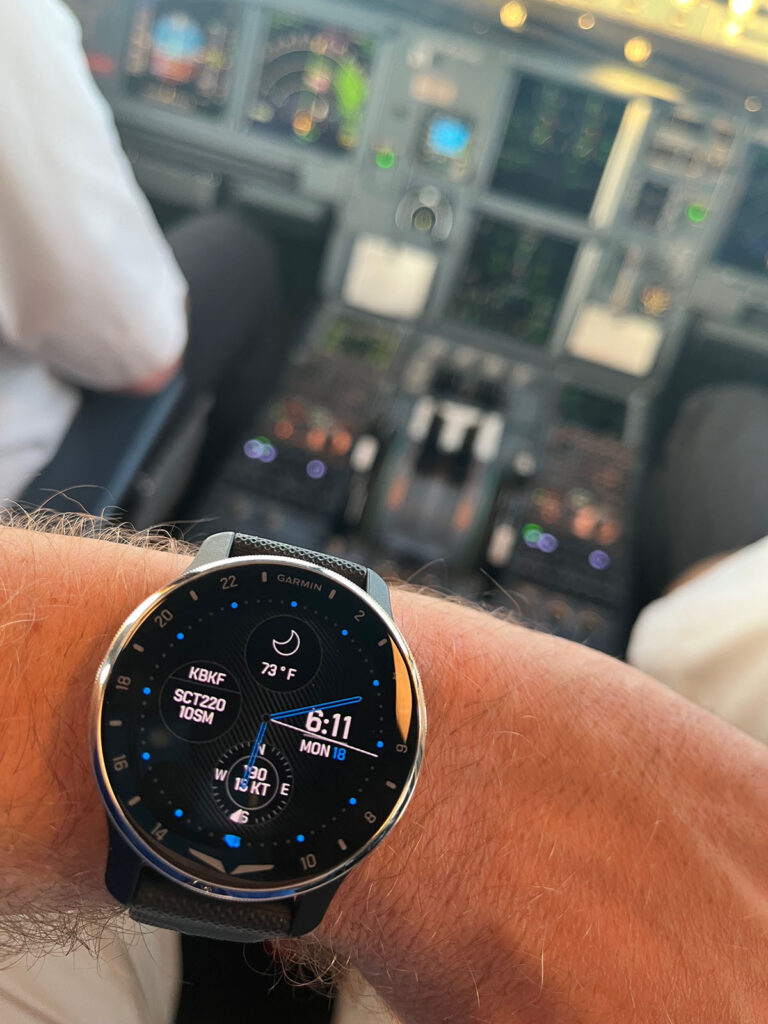
On April 23, Cianciolo was flying an Embraer E145 when he wore his D2 Air X10 on its inaugural flight.
“I hadn’t even had the watch for a week,” he said. “I was flying from Charlotte to Ohio, and we had just leveled off at 34,000 feet, and we were maybe 100 miles from Charlotte heading north. Before getting onto the plane, I had set my watch for the low altitude oxygen level to be 8,000 feet and any other altitude for 10,000 feet; the plane normally goes up to 8,000 in the cabin automatically. Anything from 8,000 feet to 10,000 feet is amber and it flashes, and when it hits 10,000 feet that’s an emergency.”
Commercial airplanes typically fly at altitudes of about 34,000 feet, but cabins are pressurized so that oxygen levels are equivalent to what they would be at 8,000 feet or lower. The higher the pressure altitude in the cabin climbs, the harder it becomes for the pilot — and in this case, the more than 50 passengers on board — to get an adequate amount of oxygen while breathing.
“We had just leveled off, and my watch started vibrating,” said Cianciolo. “I was like, ‘that’s weird.’ I was showing my first officer. Sure enough, I looked at the EICAS pressurization page, and it showed 8,100 feet amber and climbing. So we quickly requested to get down to 10,000 feet with ATC, and we started our descent immediately. I was able to reverse the trend at 9,100 feet. The watch actually alerted me before the plane did. We never declared an emergency thanks to the watch.”
Cianciolo, who had originally been considering a smartwatch not specifically built for pilots, wears his D2 Air X10 around the clock now.
“This watch is definitely a must-have, especially after the event,” he said. “After the fact, I’ve been playing with it more — I even sleep with it.” The D2 Air X10, like most Garmin smartwatches, boasts a long list of features, and Cianciolo is taking full advantage.
“I use everything, really. I actually just got back from a trip up in Maine, so I’ve been using a lot of the apps lately, such as hiking and running. I use it for weather a lot — if I want to look at weather1 or different airport information, I’ll use that. And of course it links to my phone. I also like the hydration app tracking to monitor how much water I’m drinking, because sometimes I forget to drink and stay hydrated.”
He nods to the altimeter app to view barometric pressure and other details, as well as more health-oriented features such as calorie tracking2, stress level tracking and the health snapshot that shows a real-time glimpse at the user’s current health and fitness status.
“I’m very amazed by the accuracy and the amount of stuff this watch can do,” he said. “It’s amazing. It’s better than any watch out there.”
To shop the Garmin D2 Air X10 or other Garmin aviator smartwatches, click here.
1When paired with your compatible smartphone and in range of BLUETOOTH® technology
2See Garmin.com/ataccuracy
The Bluetooth word mark and logos are registered trademarks owned by Bluetooth SIG, Inc. and any use of such marks by Garmin is under license.
The post Garmin Smartwatch Alerts Pilot to Climbing Cabin Pressure appeared first on Garmin Blog.
https://www.garmin.com/en-US/blog/aviation/garmin-smartwatch-alerts-pilot-to-climbing-cabin-pressure/
Garmin Aviation Smartwatches: Tools for Flying — and More
Not long after the first pilots earned their wings did the first aviator watches find their way onto their wrists. In those early years of aviation, pilots demanded timepieces that were accurate, easy to see and easy to use. And while aviation has come a long way in nearly 120 years of powered flight, a trusted watch remains essential for flight.
We’ve built on this tradition by creating three smartwatches purpose-built for your flying — each tailored to your desires and budget. All can help you show your pride in your pilot lifestyle, with vivid displays and iconic aviation-themed design, but they’re way more than just stylish. They put advanced tools for flying, fitness and connectivity right at your wrist. With that in mind, here are five ways our aviation smartwatches can help you get the most out of your time in the air — and every other moment of your life too.
1. Put weather at your fingertips.
Foremost, an aviation watch should help a pilot execute a safe flight. That starts with planning. Get a clear view of weather conditions during preflight by accessing aviation weather, including METARs and TAFs, to show winds, visibility, barometric pressure and more1. Our D2 Mach 1 even adds MOS forecasts and meteogram projections for U.S. airports1 — plus customizable notifications for changing conditions. And both D2 Mach 1 and our luxury MARQ® Aviator feature NEXRAD radar overlaid on a full-color moving map when you sync your flight plan wirelessly from the Garmin Pilot
Mach 1 even adds MOS forecasts and meteogram projections for U.S. airports1 — plus customizable notifications for changing conditions. And both D2 Mach 1 and our luxury MARQ® Aviator feature NEXRAD radar overlaid on a full-color moving map when you sync your flight plan wirelessly from the Garmin Pilot app on your compatible smartphone.
app on your compatible smartphone.
2. Navigate from your wrist.
As a pilot, you know the importance of having a Plan B, Plan C or even Plan D. With our aviation smartwatches, you’ll have backup navigation to keep you on course. Fly Direct-to a location or waypoint in the built-in worldwide aeronautical database — or choose the Nearest function to activate a path to a nearby airport. Follow the instrument-like HSI course needle to easily see if you’re left or right of your desired flight path. And view runway orientation, lengths and airport frequencies so you’re prepared when you reach your destination.
3. Be aware at altitude.
You can monitor yourself while en route too. Check your Pulse Ox2 to gain awareness of how well your body’s oxygen levels are adjusting to the thinner air at higher altitudes. Use the barometric altimeter to know when you’ve reached your desired altitude — or get a vibration alert when you reach an altitude where supplemental oxygen may be required. And manually set other alerts to remind you when it’s time to switch fuel tanks or perform other time-critical tasks. Keeping your logbook up to date is always a pain. Our D2 aviation smartwatches make it easier. You can automatically log your flights on the watch and sync them to the Garmin Pilot app, then automatically transfer date, duration, total flight time and route to your flyGarmin.com account1 for easier currency tracking and logging. How’s that for keeping your logbook up to date?
4. Make time for fitness.
Between flights, our aviation smartwatches allow you to track your health. Use the Health Snapshot feature to show heart rate3, heart rate variability, Pulse Ox2, respiration and stress. See your body’s energy levels so you can find the best times for activity and rest.Use preloaded profiles for more than 25 activities, including trail running, swimming, running, biking, hiking and more. And get a score for your sleep quality plus insights on how you can do better. All provide extended battery life of more than 7 days in smartwatch mode so you can you get an uninterrupted picture of your wellness to stay in top flying form.
feature to show heart rate3, heart rate variability, Pulse Ox2, respiration and stress. See your body’s energy levels so you can find the best times for activity and rest.Use preloaded profiles for more than 25 activities, including trail running, swimming, running, biking, hiking and more. And get a score for your sleep quality plus insights on how you can do better. All provide extended battery life of more than 7 days in smartwatch mode so you can you get an uninterrupted picture of your wellness to stay in top flying form.
5. Stay connected from anywhere.
Lastly, our smartwatches keep you in tune with your life. Receive emails, texts and alerts right on your watch when paired with your compatible smartphone. D2 Air X10 even allows you to make calls from your wrist, plus create or respond to text messages hands-free, courtesy of your paired compatible smartphone’s voice assistant. You can also download songs and playlists from your Spotify®, Deezer or Amazon Music accounts (subscription may be required) and use your wireless headphones for phone-free listening. Plus, you can breeze through checkout lines and select transit systems with the Garmin Pay
Air X10 even allows you to make calls from your wrist, plus create or respond to text messages hands-free, courtesy of your paired compatible smartphone’s voice assistant. You can also download songs and playlists from your Spotify®, Deezer or Amazon Music accounts (subscription may be required) and use your wireless headphones for phone-free listening. Plus, you can breeze through checkout lines and select transit systems with the Garmin Pay contactless payment solution through participating providers.
contactless payment solution through participating providers.
With a modern, impressive set of features, our aviation smartwatches provide capabilities that early pilots could hardly imagine. But they’re just the tools you’ll want to help you fly, keep active and stay connected. That kind of smart will look good on you.
1 When paired with a compatible smartphone, with a data connection, and in range of BLUETOOTH® technology
2This is not a medical device and is not intended for use in the diagnosis or monitoring of any medical condition; see Garmin.com/ataccuracy. Pulse Ox not available in all countries.
SPOTIFY and the Spotify logo are among the registered trademarks of Spotify AB.
Amazon Music and all related logos are trademarks of Amazon.com, Inc. or its affiliates.
The Bluetooth word mark and logos are registered trademarks owned by Bluetooth SIG, Inc. and any use of such marks by Garmin is under license.
The post Garmin Aviation Smartwatches: Tools for Flying — and More appeared first on Garmin Blog.
https://www.garmin.com/en-US/blog/aviation/garmin-aviation-smartwatches-tools-for-flying-and-more/
Welcome to Oshkosh: Garmin’s Guide to the World’s Biggest Aviation Event
“Welcome to Oshkosh.” These are words that pilots have heard from controllers since the inaugural EAA Fly-in in Oshkosh in 1970. And ever since, pilots, aviation enthusiasts and families from around the globe have convened at Wittman Regional Airport the last week of July to celebrate everything that is aviation.
Heading to Oshkosh for the first time this year? We can help. Take a look at a few of our top tips and tricks on how to make your Wisconsin adventure the best it can be.
Flying in? Review the FAA notice for the event.
Every year EAA and FAA officials collaborate on the annual NOTAM for pilots to reference while flying into Oshkosh and other area airports. The EAA has also compiled an arrival video to showcase landmarks and other waypoints to use while on the Fisk VFR arrival or any other VFR or IFR route to the show. You can find the newly renamed FAA notice as well as a detailed video on the Fisk VFR arrival here.
Create new traditions
Oshkosh is a magical place — an event that seemingly rises out of the Wisconsin dirt into the Wisconsin sky for a week a year. Everyone experiences Oshkosh differently, which makes for an endless list of traditions. Take your annual family photo in front of the Brown Arch and tag it on social with #OSH22, camp under the wing of your airplane, catch a night airshow, meet an aviation hero or favorite aviation social media ambassador, or simply take in the 12,000 aircraft that descend into Wittman Regional Airport during the week and take home a lifetime of memories. Oshkosh is a special place that you’ll never forget.
Learn from the best
The annual EAA fly-in, now known as AirVenture Oshkosh, has always been a great place to learn about latest and greatest aviation products and findings and keep up your pilot proficiency. Garmin hosts many educational seminars about our products and offerings during the event. EAA and other aviation entities host almost a thousand more forums and presentations, and that full list can be found here.
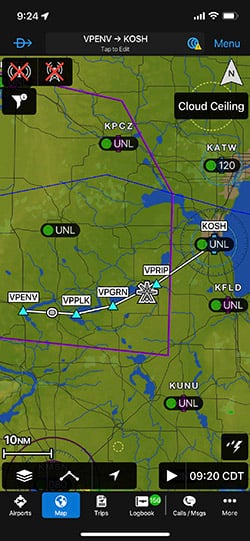
Pre-plan your trip with Garmin
Flying with Garmin avionics or the Garmin Pilot app? Take a look at the FAA notice and load the Fisk VFR arrival waypoints into your flight plan with ease.
app? Take a look at the FAA notice and load the Fisk VFR arrival waypoints into your flight plan with ease.
Are you as excited for AirVenture as we are? Check out the Garmin Oshkosh website here to see our latest announcements, show seminar schedule and learn more about how Garmin can help you at the show. Hope to see you stop by our exhibit on Celebration Way!
The post Welcome to Oshkosh: Garmin’s Guide to the World’s Biggest Aviation Event appeared first on Garmin Blog.
https://www.garmin.com/en-US/blog/aviation/welcome-to-oshkosh-garmins-guide-to-the-worlds-biggest-aviation-event/
Five Benefits of Flying with Smart Rudder Bias in Your Twin
One of the advantages of operating a twin-engine aircraft is enhanced peace of mind from engine redundancy. Yet an engine failure in these aircraft can present a safety risk of its own. When that happens, you must act quickly to correct the potentially hazardous aerodynamic effects of flying with only one operating engine.
Garmin Smart Rudder Bias provides assistance in these situations. It’s available in select aircraft equipped with a GFC 600 autopilot with the yaw option and G500 TXi or G600 TXi primary flight displays with engine indications. And it automatically does several things that help give you time to react and remain in control.
600 autopilot with the yaw option and G500 TXi or G600 TXi primary flight displays with engine indications. And it automatically does several things that help give you time to react and remain in control.
1. It’s available soon after takeoff.
Engine failures are particularly critical on climbout. That’s why Smart Rudder Bias is available as soon as the airplane reaches minimum controllable airspeed. But it also constantly monitors the aircraft throughout the entire flight, because failures can happen at any time. And it offers protection whether your autopilot is on or off.
2. It identifies the failing engine.
The system determines a one-engine inoperative condition by using the engine indication system. It compares power output between the two engines, and if it detects that a power difference exceeds a predetermined threshold, it indicates which engine is failing. That helps you more quickly confirm the failure.
3. It applies rudder to correct yaw.
Once it recognizes the failure, Smart Rudder Bias activates to help counteract the aerodynamic changes that occur because of the failure. It immediately provides rudder force to help you overcome the yaw tendency from the loss of power and added drag so you have time to complete procedures and maintain control of the aircraft.
4. It adds elevator and pitch inputs to maintain control.
When necessary, the system applies modified Electronic Stability and Protection control inputs. If your bank angle exceeds preset limits because of the roll tendency, it adds aileron inputs to help you increase or decrease bank — even in turns. It also provides elevator inputs to help you pitch for safe airspeed and avoid a stall.
5. It’s easily disengaged once you’re in control.
Once you’ve reestablished stable flight, you can deactivate Smart Rudder Bias with a panel-mounted switch and fly to a suitable airport for an emergency landing. If you’re able to restore power to the failed engine, you can also rearm Smart Rudder Bias to provide continued protection during two-engine flight.
Are you ready to add Smart Rudder Bias to your twin? Just contact your local Garmin authorized dealer to discuss how to equip your aircraft. You can also visit our GFC 600 page to learn more about how it can help during a one-engine inoperative condition.
The post Five Benefits of Flying with Smart Rudder Bias in Your Twin appeared first on Garmin Blog.
https://www.garmin.com/en-US/blog/aviation/five-benefits-of-flying-with-smart-rudder-bias-in-your-twin/
